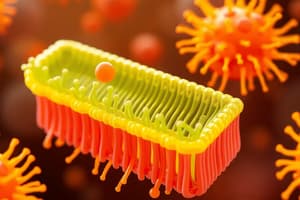Podcast
Questions and Answers
What is the primary component of the plasma membrane?
What is the primary component of the plasma membrane?
- Phospholipids (correct)
- Proteins
- Cholesterol
- Carbohydrates
Which part of the phospholipid molecule is hydrophobic?
Which part of the phospholipid molecule is hydrophobic?
- Hydrophilic head
- Fatty acids (correct)
- Charged groups
- Phosphate
What is the function of cholesterol in the plasma membrane?
What is the function of cholesterol in the plasma membrane?
- Transport molecules across the membrane
- Generate energy for cellular processes
- Facilitate communication within the cell
- Act as a stabilizer (correct)
What is the role of integral membrane proteins in the plasma membrane?
What is the role of integral membrane proteins in the plasma membrane?
In a phospholipid bilayer, where do the hydrophilic heads face?
In a phospholipid bilayer, where do the hydrophilic heads face?
Which molecule prevents phospholipid tails from coming into close contact with water?
Which molecule prevents phospholipid tails from coming into close contact with water?
What type of interactions are responsible for attaching peripheral membrane proteins to the membrane?
What type of interactions are responsible for attaching peripheral membrane proteins to the membrane?
How does the plasma membrane contribute to maintaining homeostasis within the cell?
How does the plasma membrane contribute to maintaining homeostasis within the cell?
Which type of transport mechanism requires energy in the form of ATP?
Which type of transport mechanism requires energy in the form of ATP?
What cellular structure is responsible for providing structural support and facilitating cellular movement?
What cellular structure is responsible for providing structural support and facilitating cellular movement?
What is the function of carrier proteins in cellular transport?
What is the function of carrier proteins in cellular transport?
In cellular communication, what initiates a series of events that lead to changes in cell behavior?
In cellular communication, what initiates a series of events that lead to changes in cell behavior?
Flashcards are hidden until you start studying
Study Notes
The Plasma Membrane: A Delicate Barrier and Conduit for Life
The plasma membrane, also known as the cell membrane, is a fundamental component of all living cells. This ever-present boundary separates the internal environment of a cell from the external world, acting as a protective barrier and a site for essential cellular processes. In this article, we'll explore the structure and function of the plasma membrane, delving into its role in cell organization, communication, and maintaining homeostasis.
Structure
The plasma membrane is primarily composed of phospholipids, cholesterol, and proteins. Phospholipids are amphipathic molecules with a hydrophilic (water-loving) head containing phosphate and charged groups, and hydrophobic (water-repelling) tails made of fatty acids. When phospholipids are mixed with water, they spontaneously organize into a bilayer, with the hydrophilic heads facing the aqueous surroundings and the hydrophobic tails facing inwards, creating an environment with distinct domains.
Cholesterol molecules are embedded within the plasma membrane, acting as a stabilizer. They prevent the phospholipid tails from coming into close contact with water, thereby maintaining the integrity of the bilayer.
Integral membrane proteins are embedded or anchored within the lipid bilayer, performing diverse functions such as transporting molecules across the membrane, acting as receptors for signaling molecules, or serving as enzymes involved in membrane-bound reactions. Peripheral membrane proteins are attached to the membrane through non-covalent interactions with other membrane components or through anchoring to the cytoskeleton.
Compartmentalization
The plasma membrane separates the cell's interior from the external environment, creating two distinct compartments: the cytosol (intracellular space) and the extracellular space. This compartmentalization allows the cell to maintain homeostasis by precisely regulating the concentrations of various molecules and ions. The membrane also serves to protect the cell from damage by external factors such as physical impact, toxins, and pathogens.
Cellular communication
Cells communicate with each other and their environment through specific signaling pathways that involve the plasma membrane. These signaling molecules, such as hormones, neurotransmitters, and growth factors, interact with membrane receptors, initiating a series of events that lead to changes in cell behavior, such as activation, proliferation, or migration.
Transport and selective permeability
The plasma membrane controls the passage of molecules and ions in and out of the cell, maintaining an appropriate balance inside and outside the cell. Passive transport relies on the diffusion of molecules down their concentration gradients, while active transport requires energy in the form of ATP to move molecules against their concentration gradients. Carrier proteins facilitate the movement of small, nonpolar molecules, while pumps and channels facilitate the movement of ions and polar molecules.
Cellular organization
The plasma membrane acts as a scaffold for the organization of cellular structures, such as the cytoskeleton and the extracellular matrix. The cytoskeleton, composed of actin, microtubules, and intermediate filaments, provides structural support and facilitates cellular movement. The extracellular matrix is a complex network of proteins and carbohydrates that anchors cells to each other and provides mechanical support. The plasma membrane is also involved in the organization of cell adhesion molecules (CAMs), which facilitate cell-to-cell interactions.
In summary, the plasma membrane is an essential component of all living cells, serving as a protective barrier and a site for diverse cellular functions. This delicate structure maintains compartmentalization, facilitates cellular communication, regulates transport, and contributes to cellular organization. A deeper understanding of the plasma membrane's structure and function is crucial for furthering our knowledge of cell biology and its applications in medicine and biotechnology.
Studying That Suits You
Use AI to generate personalized quizzes and flashcards to suit your learning preferences.




